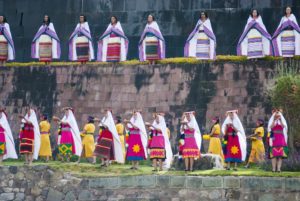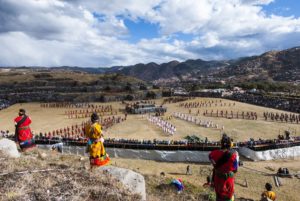In the Quechuan language, Inti Raymi means sun festival, and that’s exactly what it is. This ancient Incan ceremony honours the sun god Inti. The festival takes place throughout the Andes. The largest celebrations occur in the Inca empire’s capital, Cusco in Peru.
The festival lasts for nine days between the winter solstice and the Inca New Year. The festivities include dancing, processions, colourful costumes and animal sacrifices. The aim is that the gods give a good crop and harvest in the coming months. It’s understandable that sun was regarded with such importance. It’s gives energy, without which, life would not exist. Incas built Temples to the sun, and believed that after death, those who had led an honest and good life would be ascend closer to the sun’s warmth.


Records suggest that the first Inti Raymi was in 1412 in the heart of the Inca capital, which is now Cusco. The festival occurred every year into 1535 when Spanish Catholic priests banned it. The festival was all but lost until 1944 when Faustino Espinosa Navarro directed a reconstruction. He used indigenous actors and notes recorded by Garcilaso de la Vega, a 16th century writer born in Cuzco.
The festival is now the second biggest festival in Latin America with well over 200,000 visitors. Both locals and tourists descend upon the Inca ruins of Sacsayhuaman just outside Cuzco, on the 24th June each year.
The festival is famous for parades, royal processions, dancing, costumes and music. Of course food and drink plays an important part in celebrations too. Plenty of hearty Peruvian fare is on offer as well as chichi morada, a purple drink made from maize and sugar.
The festivities begin in front of the Santo Domingo Church (once the site of the Sun Temple). Here in Koricancha Square performers re-enact the Sun king, Sapa Inca, giving prayers to the sun. Afterwards, Sapa Inca and wife are carried in thrones up to Sacsayhuaman, followed by priests. Here more prayers and worship aimed at the sun god Inti and the Pachamama, the goddess of mother earth. Originally children and llamas were sacrificed, their organs used by high priests to predict the future. Today much dancing ensues with a great fire lit at sunset .
If you wish to visit Inti Raymi there are a couple of things to remember. Most of Cusco’s hotels get booked up many months before the event, so ensure that you book early to avoid disappointment. Entrance into Sacsayhuaman is free on the day, but reserved seats are only available if purchased in advance.
Image credit: Heinz Plenge Pardo